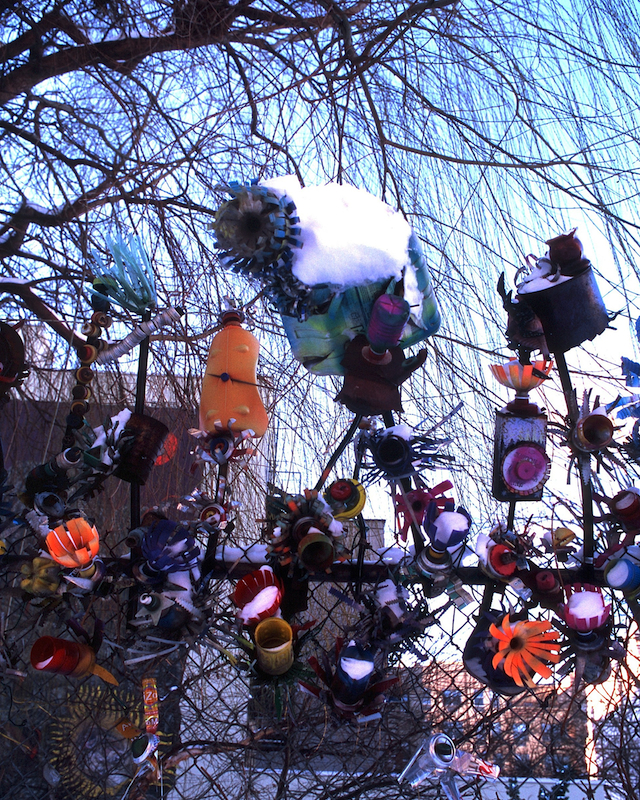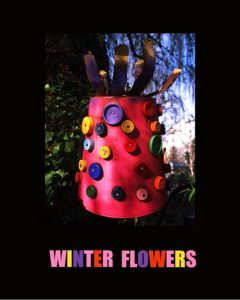East Village “Winter Flowers” — Where Will They Bloom Again?
The corner of East 9th Street and Avenue C looks rather naked to some local residents. But it’s not because it is February and the trees are bare. It’s because La Plaza Cultural de Armando Perez Community Garden, located on that corner, is bereft of the iconic public art project which adorned its fence. The Winter Flowers by artist Rolando Politi are down for now, but they may sprout up around again.

The fence looks sad to anyone used to seeing the festoon of festive flowers fashioned from recycled materials which used to reside there. The jamboree of aluminum cans and plastic detergent bottles that appeared to have sprung to life and assumed their real forms first appeared here in 2000.

La Plaza Cultural de Armando Perez Community Garden will be closing on or around February 24, 2019 until early summer. The Parks Department and Green Thumb will be replacing the existing rusted and sagging fence with something much better. For a portion of the time of the closure, the garden will be fenced off and not accessible to the public or gardeners.
But this is not the end of the story for the Winter Flowers, which has been an evolving and growing project from the beginning, and will continue to evolve. Before each flower was made and hung on the fence, they were hand-picked from the local waste stream by Mr. Politi. As he says, “ their reuse implies social responsibility. Ever since the Eighties, I have felt that we use an excessive amount of consumer packaging.” One of his first “solo” exhibitions was held at the original ABC no RIO and was titled “Packaging Inferno”, well before recycling became mandatory in New York City.

La Plaza Cultural de Armando Perez Community Garden is a unique open-air theater and green space, combining the functions of a community garden, a park and play area, wildlife refuge and performance venue. Thousands of people from diverse cultures use the space every year. It is a vital arena for theater, dance, music, art and social gatherings.
La Plaza Cultural de Armando Perez Community Garden was founded in 1976 by local residents and greening activists who took over what were then a series of vacant city lots piled high with rubble and trash. In an effort to improve the neighborhood during a downward trend of disinvestment, arson, drugs, and abandonment common in that era, members of the Latino group CHARAS cleared out truckloads of refuse. Working with Buckminster Fuller, they built a geodesic dome in the open “plaza” and began staging cultural events. Green Guerillas pioneer Liz Christy seeded the turf with “seed bombs” and planted towering weeping willows and linden trees. Artist Gordon Matta-Clark helped construct La Plaza’s amphitheater using railroad ties and materials reclaimed from abandoned buildings. I recall going to eclectic open-air flea markets and musical performances on weekends there when I was in high school.

In 2003, La Plaza was renamed in memory of Armando Perez, a CHARAS founder and former District Leader of the Lower East Side who was killed in 1999.
During the Giuliani era, when hundreds of community gardens were threatened with demolition, Mr. Politi felt that the sculptures would attract attention to the preservation issue and campaign. The location on the top of the fence “was an issue of safety and security. Safety as they were not reachable by children and security since they heightened the fence by 2/3 feet making it harder to jump over!”
The hundreds of flowers were removed last year in anticipation of the new fence. Mr. Politi plans to restore all the ones that can still be restored, which is most of them. And he will mix old and new transforming a piece into an entirely new piece when needed. His interest is in having the refurbished pieces remain in the neighborhood, spread out in more than one location.
The larger pieces were installed in the top canopy which he made entirely by himself.
The lower canopy consisted of smaller flowers and daisy spinners which children like the most! He has conducted workshops on the site with local students from the LES Girls Club and the Earth School, among others.
If you or your organization have space to accommodate a temporary month or months-long workshop for Mr. Politi to be able to work on this project, please let me know at hbubbins<@>gvshp.org.
Currently, there is a limited edition book out about this fantastic art installation by local photographer Paul Adrian Davies.

The book is limited to only 100 copies in glossy perfect bound wrappers, with an introduction by the artist. What was an ongoing public project at La Plaza Cultural Community Garden at the southwest corner of 9th street and Avenue C on the Lower East Side, this project is now documented here in book form for the first time.
Photographer and local resident Paul Adrian Davies’ beautiful naturalistic images brings The Winter Flowers to life on paper. To order a copy contact Mr. Politi at recycleandpray@gmail.com.

Mr. Davies lives only two blocks from La Plaza Cultural community garden and walks by it multiple times a week. He has watched the Winter Flowers grow organically for almost twenty years from a handful of individual sculptures to a work of art adorning the entire perimeter fence of the garden with hundreds and hundreds of handmade elements.
Like many in our area, Mr. Davies knew Mr. Politi by sight for quite a long time, and knew that he was the artist responsible for the unique installation. Mr. Davies said “One day about three years ago I saw him on his usual perch on top of a step ladder installing a sculpture high up on the fence. I asked if I could take a photograph of him at work. He agreed so I did.” He continued:
I made him a print and we had coffee and got to know each other a little better. He told me that the fence was about to be replaced with a new fence and Winter Flowers would at that point cease to exist in its current form.
I asked him if he had a good photographic document of Winter Flowers. He told me that hundreds of people had photographed his work over the years but he had hardly ever seen any of the results. He had not photographed his own work. So the answer was no. I offered to create a photographic archive of his work which is one of the most iconic public art projects in the history of the Lower East Side and deserved to be recorded and thus remembered.
When I too got up on top of the step ladder to take photographs I immediately recognized the beauty and craftsmanship of each individual piece. Each sculpture is unique. Rolando and I talked about this and over time Rolando decided to save as many of them as feasible and has now started to display them in different environments. Winter Flowers will live on.

